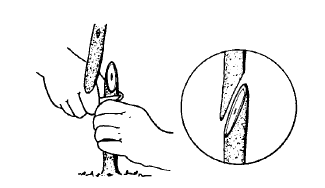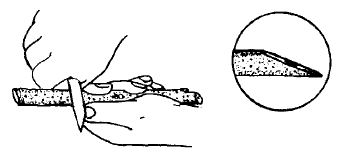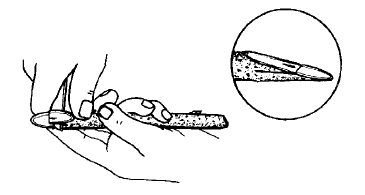Whip and Tongue Grafting Pecans
The whip and tongue graft has many uses. It is well adapted for propagation of small seedling pecan trees and branches of larger trees and is commonly used in nursery crops and woody ornamentals. The best time to graft is from February to early April before growth starts.
You will need a sharp knife and masking or grafting tape. Some grafters use orange shellac. In extremely dry, windy conditions, shellac may improve grafting success.
Use dormant one-year-old graft wood (scion). Graftwood should be collected when the trees are fully dormant. Late December and January are good times to collect propagation wood. Instructions for collecting and storing propagation wood is found in fact sheet HLA-6217. Graftwood may also be purchased from reputable sources. The diameter of the scion and stock (tree or branch) should be as nearly the same size as possible to assure maximum contact. The preferred size is 3/8 to 3/4 inch diameter. However, one-inch stocks and scions have been successfully used.
Each scion should contain at least two buds and be about six inches long. Small trees should be grafted near the ground line to reduce maintenance. Care should be used to avoid touching the cut surfaces.

1. First, cut off the tree trunk or branch by making a long, straight, sloping cut. The face of the cut should be two to three inches long. Try to make the cut with one stroke of the knife.
 2. To make the tongue, start a cut about 1/3 the distance from the tip of the cutoff
tree and press the knife slowly downward (a rocking motion will aid in making the
cut) about 2/3 the length of the bevel cut on the trunk. Be careful not to split the
wood. Do not loosen the bark.
2. To make the tongue, start a cut about 1/3 the distance from the tip of the cutoff
tree and press the knife slowly downward (a rocking motion will aid in making the
cut) about 2/3 the length of the bevel cut on the trunk. Be careful not to split the
wood. Do not loosen the bark.

3. Make a similar sloping cut on the basal end of the scion. Hold the scion wood in one hand and cut by pushing the blade away from the body.

4. Make the tongue cut on the scion in the same manner as on the trunk or stock.

5. Match the parts together. If the two parts are not the same size, be sure to match one side of the scion and rootstock. If the cuts are made properly and the rootstock and scion are the same diameter, the stock and scion will appear as one.

6. Wrap the union tightly with masking tape or grafting tape to exclude air and hold the union firmly together. Poly budding tape may also be used for this wrap but may need to be removed later. The tape should extend above and below the graft union. The taped area and scion can be covered with orange shellac to prevent excessive moisture loss.
When two-year-old scion wood is used, new shoot growth may be delayed as much as three weeks, but growth may be very rapid when it starts.
Nurserymen produce stocks for grafting by planting pecan nuts 3 or 4 inches apart in rows. The young trees are usually grafted at the beginning of the second or third year’s growth. Vigorous trees that are 3/8 to 3/4 inch in diameter at 6 to 12 inches above the ground and spaced 8 to 12 inches apart are selected. Excess trees are removed to provide room for rapid growth so the trees will be ready for digging and transplanting the following season.
If several nuts have been planted where a permanent tree location is desired, select the best seedling tree and remove the least desirable ones at the end of the first growing season. After one or two additional growing seasons, the selected seedling tree may be changed to an improved variety via a whip and tongue graft.
Nurseries often use the whip and tongue graft on container trees to bench graft. Growers bring the containers inside to graft on the bench and then are kept protected from freezing temperatures until planting time.
Young native or seedling pecan trees growing in a good location in fields or pastures can be propagated to improved varieties. Whip and tongue grafts can be made on the central leader at whatever height is necessary to accommodate the size of the propagation wood.
Remember to follow through with proper maintenance such as removal of native sprouts, cutting the tape, and, in some instances, staking the tree.
Becky Carroll
Extension Assistant
